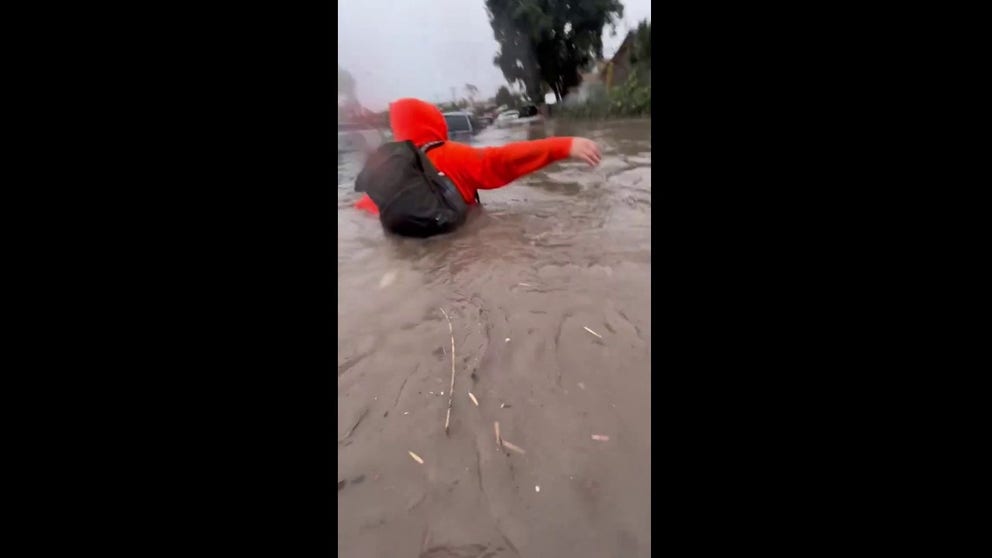West Coast soaked by astounding 51 atmospheric rivers this winter
The record rain and snowfall water year 2022-23 saw 38 landfalling atmospheric rivers on the West Coast while an average year sees 24.
Atmospheric rivers explained: What you need to know
What is an atmospheric river? The largest freshwater 'rivers' on Earth, atmospheric rivers are long, narrow bands of highly concentrated water vapor flowing in the atmosphere.
The West Coast was drenched this winter by an astounding 51 atmospheric rivers from fall 2023 to spring 2024, according to the Center for Western Weather and Water Extremes. The tally was more than twice the average.
On average, 24 atmospheric rivers (AR) make landfall on the West Coast each winter, according to Department of Energy research. California usually sees just four or five a year, said a California Department of Resources official. This winter, four soaked Southern California alone.
SOME OF THE MOST CATASTROPHIC ATMOSPHERIC RIVERS AND FLOODING IN CALIFORNIA HISTORY
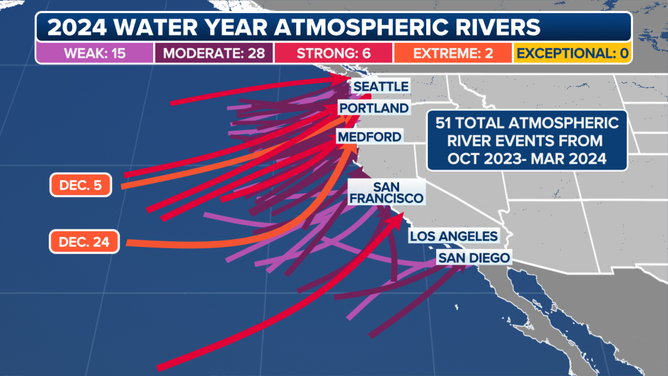
Fifty-one atmospheric rivers make landfall on the West Coast in the 2023-24 season.
(FOX Weather)
And the Southern California drenching was an oddity considering the El Niño climate pattern in control. The ARs were also warmer, meaning they delivered more rain and less snow.
"What's different about this year is that they're coming in warm, lots of activity in Southern California, which isn't traditional for an El Niño year," explained California Department of Water Resources Director Karla Nemeth in a February interview. "Usually Southern California tends to run a little bit drier in El Niño conditions. So we reserve the right to be surprised with what hydrology, presents to us."
October through December did start slowly, according to C3WE, with only 18 ARs making landfall in Northern California. Six were rated as moderate strength. Then the state saw 25 from January to March – nine of which ranked moderate and two strong - and the snow and water supply caught up.
LOS ANGELES, SAN DIEGO UNDER STATE OF EMERGENCY AS ATMOSPHERIC RIVER LASHES SOUTHERN CALIFORNIA
Deadly AR storms
The strongest AR in 2024 hit Central and Southern California in early February. Los Angeles saw 8.51 inches of rain over three days, the second-wettest three-day stretch in the city's history. At the same time, the Sierra Nevada snowpack increased by 10-20%.
NOAA's Weather Prediction Center issued a rare "high risk" flood threat, the highest rung on the threat scale, warning of life-threatening and urban flash flooding.
SAN DIEGO FLOODWATERS PROMPT DRAMATIC RESCUES AS REGION SEES RECORD RAIN
Family escapes flooded home in waist-deep water
Listen to the fear and exhaustion as two San Diego residents struggle, wading through waist-deep flood water to escape their family home.
RIDICULOUS PHOTOS SHOW AFTERMATH OF 12 FEET OF SNOW IN CALIFORNIA'S SIERRA NEVADA
Record year for rain and snow 2022-23
The 2022-23 water year saw 38 landfalling ARs – fewer than in 2024, but many in 2023 were stronger. That year, California had seven strong, extreme or exceptional ARs which nearly equaled the amount of water seen in the three prior years of drought. In 2024, the state only saw two.
"The water year 2023 was dominated by a more southern storm track, bringing stronger and more frequent ARs to California compared to the WY [Water Year] 2024," wrote CW3E. "The variation in storm track and storm strength during WY 2024 resulted in more widespread to near normal conditions across the West instead of the dipole (north versus south) and near record-breaking precipitation in California in WY 2023."
'IT'S SO HEARTBREAKING:' 75% OF TOWN DAMAGED BY WASHINGTON FLOOD
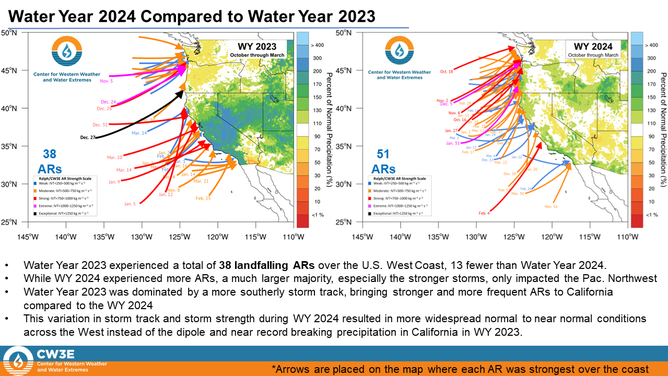
WY 2024 saw more but less intense ARs than 2023.
(Center for Western Weather and Water Extremes / FOX Weather)
Recent ARs changing the way water managers are doing business
Recent AR years changed the way California collects drinking water.
The barrage of atmospheric rivers over the winter of 2022-23 saved California from years of record drought, which is not uncommon. Between 1950 and 2010, atmospheric rivers ended three out of four droughts in the Pacific Northwest. The river of water vapor in the sky is responsible for about 50% of the West Coast's water supply.
And the ARs fill California's reservoirs over the winter. That also prevents flooding downstream. But the recent active AR years forced water managers to rethink water capture. Because the large lakes need capacity to catch not only more storm runoff but melting snow all spring and summer long. The snowmelt supplies 30% of the state's water needs.
The DWR previously released water from reservoirs to make more space into rivers flowing to the ocean. Now officials started diverting the released water to other above ground reservoirs or to settling ponds to recharge the groundwater. Water percolates from the ponds and replenishes groundwater basins or aquifers.
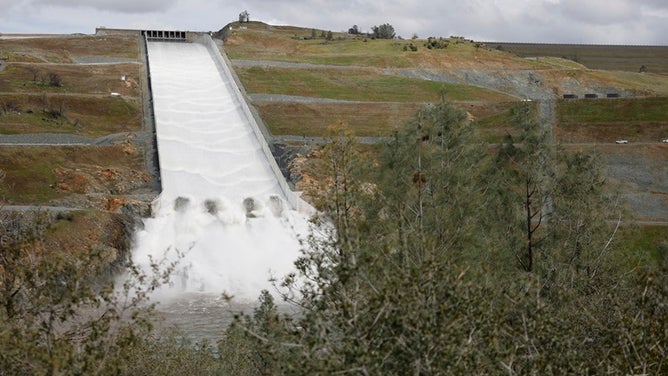
File: The Oroville Dam spillway was opened for first time since 2019 in March 2023.
(California Department of Water Resources / FOX Weather)
"And that's really essential for how California survives in drought, taking care of those groundwater basins during a drought. They provide us about 60% of our water supply," Nemeth said. "And believe it or not, our below ground aquifers have about 10 times the amount of storage than our above ground reservoirs do. So reservoirs are important, but they're only part of the story."
California grows more than a third of all vegetables and three-quarters of the fruits and nuts consumed in the U.S., according to the California Department of Food and Agriculture. So, the California water supply is a national concern.
Nemeth said that research trends show warm AR storms will become the norm.
"Overall, the trends are that, more of our precipitation is going to come as rain. It's not going to come as snow," Nemeth continued. "And that means we have to adjust the way we're ready for that water. It'll just come in more flashy, larger storm events and getting ready to store it in reservoirs and spreading it out, and getting that, recharge of our groundwater basins is going to be an essential adaptation to those newer kinds of conditions."
CALIFORNIA WATER SUPPLY RESCUED BY ‘MIRACLE MARCH’ SNOWPACK FROM SEVERAL ATMOSPHERIC RIVERS
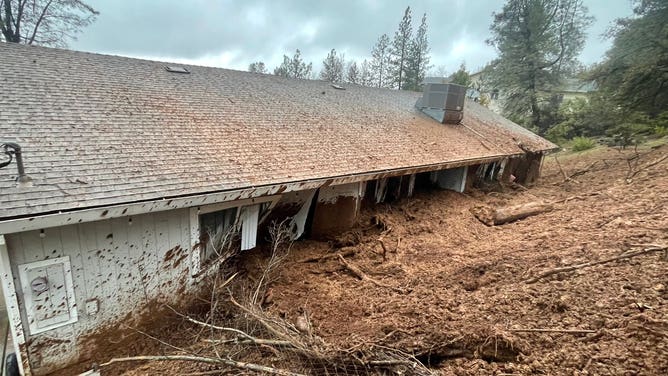
File: An AR storm's excessive rainfall triggered a landslide which crashed into a home in Colfax, California on March 14, 2023.
(CAL FIRE / FOX Weather)
ARs are major water movers
The massive ARs carry the equivalent of the water flowing from the Mississippi River, according to NOAA. Strong ARs can carry the water vapor of up to 15 Mississippi Rivers.
Across the world, there are usually four or five active ARs transporting water at any time, according to the DOE. They are responsible for 90% of the moisture transfer from the tropics to the poles.

An animation showing AR plumes across the Pacific in January 2012.
(NOAA)
The ‘big one’ may be an AR
The next "big one" for California may not be an earthquake, suggests the U.S. Geological Survey, but an "atmospheric river-driven mega-storm."
USGS scientists have developed ARkStorm, a hypothetical, scientifically realistic future winter storm scenario, to figure out all the details of what such an event would look like," wrote the USGS. "ARkStorm (for Atmospheric River 1,000) was designed to be similar in intensity to the California winter storms of 1861 and 1862, the largest and longest California storms in the historic record and the cause of the Great Flood of 1862. This type of storm would produce precipitation at levels only experienced on average once every 500 to 1,000 years."



